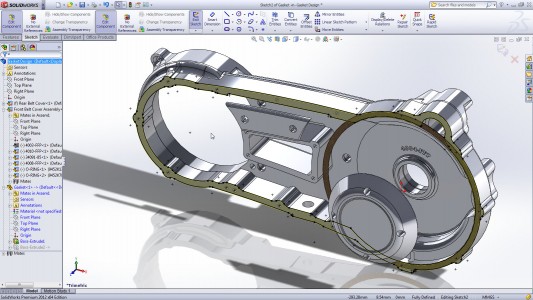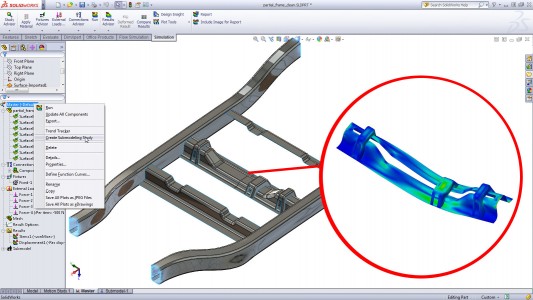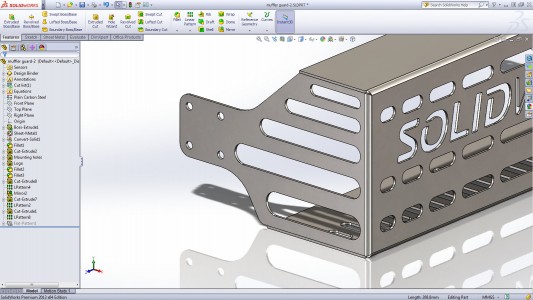The 2013 release was shown to the press last week in an event that allowed the company to take the high road, ignoring FUD thrown by others.
By Randall S. Newton
The latest version of SolidWorks was introduced to the press and blogger corps last week by a Dassault Systèmes SolidWorks executive team that appeared clear on its mission, seemingly unaffected by the storm of fear, uncertainty, and doubt—FUD—pitched in its directions in recent months by competitors and some members of the press.
SolidWorks 2013 continues the recent trend of tweaking many little things that add up to a better user experience, or as Director of Product Management Fielder Hiss put it, continuing to work on ending “death by one thousand paper cuts” through small delays. SolidWorks is also being more focused on providing extensions to the basic product to address “adjacent markets;” in the last three months SolidWorks Plastics and SolidWorks Electrical have come to market.

There has been much discussion in recent months about the direction Dassault Systèmes is taking SolidWorks. Hinted at for a couple of years, the company made clear in February 2012 it is working on a new version of the product that will replace the 3D kernel—the foundation and heart of any 3D CAD program. From its launch in 1995 until today, SolidWorks has been based on Parasolid, a 3D kernel developed and maintained by DS archrival Siemens PLM Software. Parasolid is used by several CAD products, and the Siemens PLM division in charge of it has always maintained strict neutrality in working with its clients. Nonetheless, the next-generation of SolidWorks will be based on CGM, a 3D kernel produced by DS, and used in Catia, Dassault’s enterprise-class design and engineering CAD suite. We can only imagine how irritating it must be to send a six-figure royalty check to an archrival every quarter to use their 3D kernel.
No one has ever questioned CGM is a powerful 3D kernel, but considerable concern has been raised about what it will mean for the SolidWorks user community to have its work in a CAD format that must be translated to be used in a next-generation SolidWorks product. Competitors have been eager to point out this potential problem; we have reported in the past about disgruntled SolidWorks customers who have migrated to Solid Edge, a SolidWorks competitor sold by Siemens PLM.
To their credit, when the SolidWorks leadership team met with the press in its new Waltham, Massachusetts headquarters September 6, they did not respond to recent comments by competitors but chose to press ahead with the vision they have laid out. It is a classy strategy that fits the market leader well.

Management has been saying for two years that SolidWorks will follow a two-track development path, but virtually no details have been released about the new product or product line. In Thursday’s meeting, SolidWorks CEO Bertrand Sicot said there would be a new product “complementary to SolidWorks” released in May 2013. Sicot stressed the product is not a SolidWorks replacement, but targeted specifically for “conceptual mechanical design needs.” Sicot says SolidWorks is on track to release a beta test version to selected users before the end of this year. This new product could well signal how SolidWorks intends to navigate the transition for its user base; start with a CGM-based product that offers new features not now available, then expand the product until it becomes too enticing for the majority of SolidWorks users to ignore.
Citing data from a variety of third-party and internal sources, SolidWorks says it is still working to win more users in a market Sicot described as enormous. He said the total addressable market for mechanical CAD (as of the end of 2011) is 4.5 million users and 1.5 million companies. Of that number, Sicot say only 33% (1.3 million users; .5 million companies) currently use MCAD software. Of that number, one-half million users and 160,000 companies are now using SolidWorks—11% of the total addressable market.

SolidWorks 2013 highlights
SolidWorks divides the new features in the 2013 release—the 21st major release—into five categories: Productivity; Innovative; Performance; Quality & Fit and Finish; and Delighters. There are more than 200 improvements in the product. Some of the more interesting include:
Conics in Sketcher—The use of conic sections in sketches provides better control of shapes for smooth transitions between existing geometries. Conic sections have been used for decades in the aircraft and shipbuilding industries because they produce smooth shapes without unwanted inflections.
Intersect Feature—Add or remove geometry from a solid by intersecting a surface model with it. Surfaces may be produced by SolidWorks, imported from styling systems such as Alias or Rhino, or generated from data scanned from physical objects.
CAD Administrator Dashboard—A single dashboard for aggregated viewing of CAD-group workstations helps system managers maintain consistent modeling and drafting standards and troubleshoot problems such as a workstation that crashes more frequently than the others.
Varying Dimension Patterns—Allows users to save time creating patterns, increase design flexibility and reduce the number of features needed for models by enabling patterned features to have variable spacing and feature dimensions. [LSW2]

Section View Assist—New functions enable drafters to create section views faster and more consistently to speed the creation of production drawings. The assistant enables customers to define half-sections and section views with jogs and offsets quickly.
SolidWorks Enterprise Product Data Management Workflow—Route documents and contact users more efficiently. New capabilities enable tasks to be routed for approval in parallel instead of only sequentially.
DraftSight/SolidWorks Enterprise PDM Integration—Access DWG files within SolidWorks EPDM from the DraftSight user interface.
Previous Release Interoperability—Users of SolidWorks 2012 (Service Pack 5) will be able to directly open SolidWorks 2013 files. 2012 users won’t be able to edit dimension-driven features of 2013 models. They will be able to use 2013 models in assemblies and as reference for creating models of molds, fixtures, and other manufacturing tools. SolidWorks plans to maintain this backward –compatibility for one release in the future.
Simulation Sub-Modeling and Incremental Meshing—Running a finite-element analysis on a large and complex part or assembly can be timing consuming. This new capability enables engineers to isolate a portion of the model for detailed analysis, enabling faster results.
Network Rendering for PhotoView 360—Faster rendering of photorealistic images by networking multiple computers to share the computational load.
Faster assembly loading—With improvement to the software’s ability to work with multiple CPU cores, an assembly of 55,000 parts that took 1 hour to load in SolidWorks 2012 will load in 20 minutes in version 2013.
eDrawings mark-ups—The new version of SolidWorks can import mark-ups created by either the desktop or mobile versions of their eDrawings viewing software.
Other highlights:
- Point at Center of Mass
- Quick Picks at Open Dialog
- Improvements to Explode View
- ePDM toolbar UI update
- New feature, EZ Section View creation
SolidWorks 2013 is now available from its global network of resellers.
L. Stephen Wolfe, P.E., a Contributing Analyst to Jon Peddie Research, provided research for this article.





